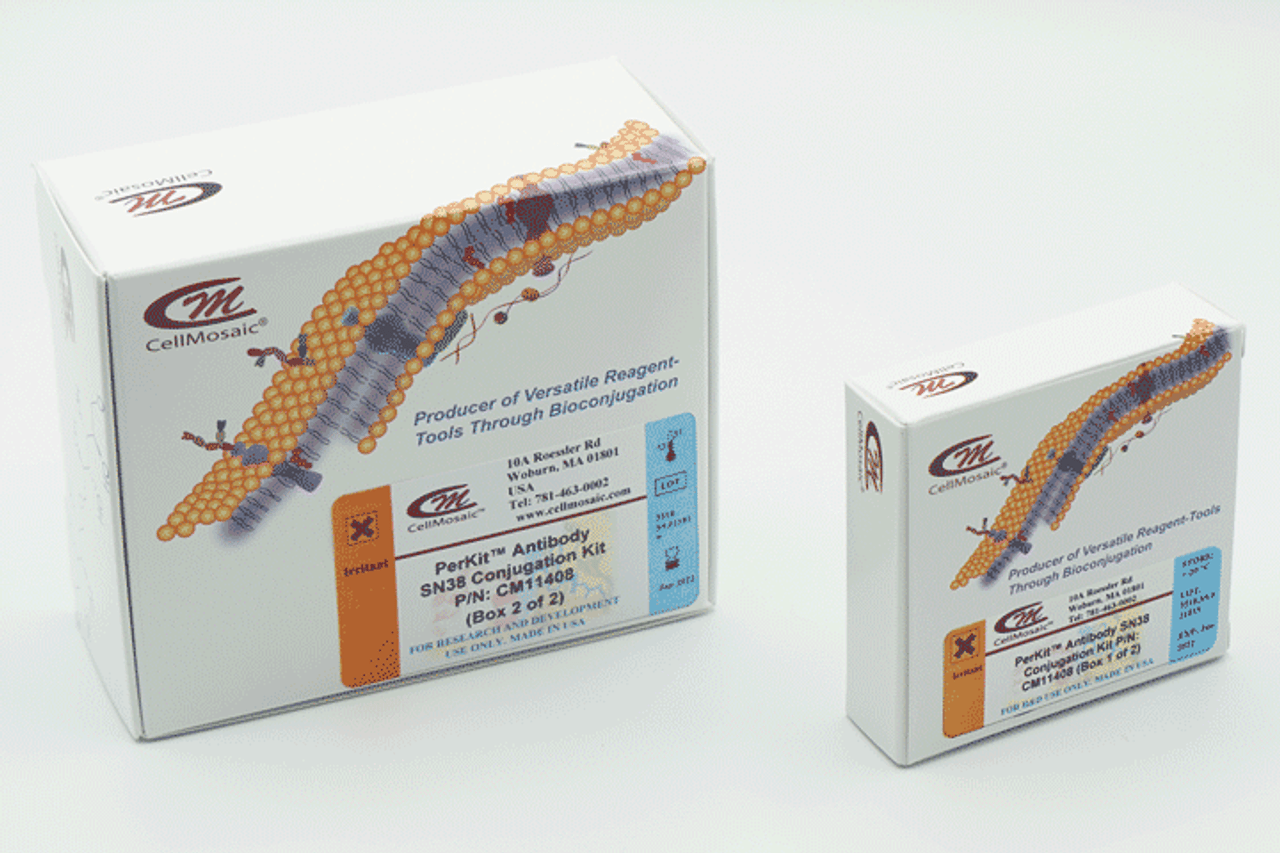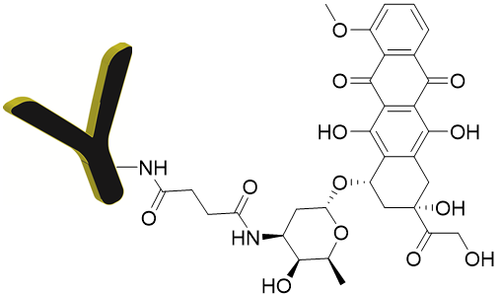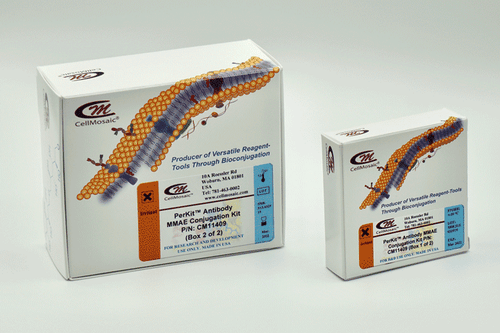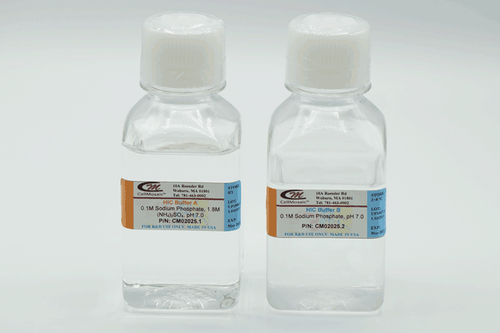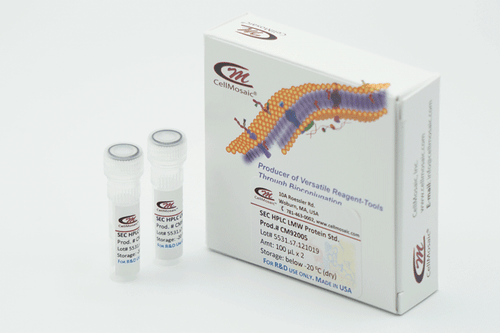Product Description
| Download Documents | |
| SDS | USER MANUAL |
CellMosaic® has designed this kit for antibody (IgG) labeling of SN38, the active metabolite of irinotecan, for early stage screening of your antibody.
Irinotecan is on the World Health Organization's List of Essential Medicines (the most effective and safe medicines needed in a health system). SN38 is 1000-times more active than irinotecan, but is not generally used as a drug due to its poor water solubility. If conjugated to a protein or antibody, the protein/antibody can transport SN38 to the active site. This kit includes O-succinyl SN38 NHS ester, which can be coupled to the antibody directly via surface amines in a single step. The product is then purified to remove any unreacted drug.
Standard Kit Configuration
| Antibody Amount per Reaction | Number of Reactions in Kit | Catalog Number |
| 1-3 mg | 1 or 3 | CM11408x1 or CM11408x3 |
If you have a smaller amount of IgG, non-IgG type antibody, or other customization needs, please select the customization radio button and/or fill out the information above.
Drug Information
- Name: SN38 (7-ethyl-10-hydroxycamptothecin)
- CAS number: 86639-52-3
- Mechanism of action: Inhibition of topoisomerase I leads to inhibition of both DNA replication and transcription.
- Medical usage: Pro-drug Irinotecan (brand name: Camptosar) is used for treatment of colon and small cell lung cancer
Requirement for Antibody
- Preferably >90% pure by gel electrophoresis
- Total amount: 1-3 mg (protein content measured by UV)
Key Features of this PerKit™
- Offers a simple and easy way to label IgG with SN38 with minimum exposure to the chemotherapeutic drug
- Releasable linkage
- Fast and easy preparation: 6 h preparation with <1 h hands-on time
- All reagents and supplies included for preparation and purification
- DAR with average 3 SN38 labeling per antibody
- Included stabilizing buffer for long-term storage
- More than 99% conjugated products by SEC and is free of any unreacted drugs
- Options to choose tailored services at CellMosaic® after conjugation
After conjugation: you can choose to send your sample to CellMosaic® for HPLC analysis and calculation of the DAR.
Conjugation Chemistry

Protocol
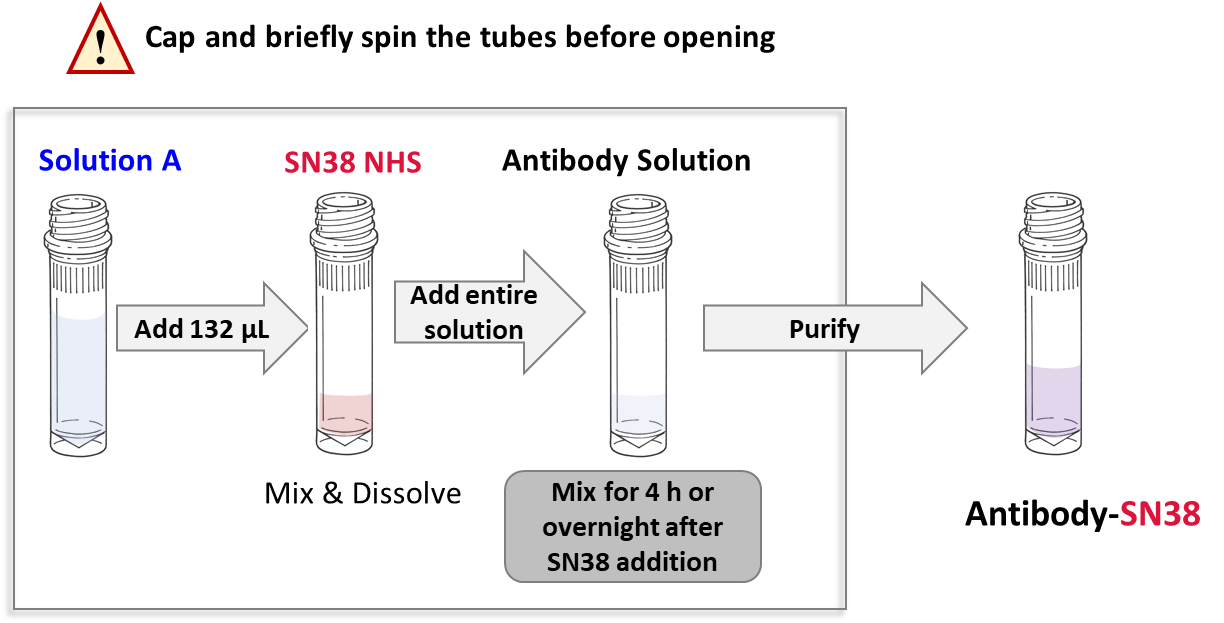
Selected Citation from Customers who Use ADC Prepared from CM11408
Micalizzi, Douglas S.; Che, Dante: Nicholson, Benjamin T.; Edd, Jon F.; Desai, Niyati; Lang, Evan R.; Toner, Mehmet; Maheswaran, Shyamala; Ting, David T.; Haber, Daniel A. "Targeting breast and pancreatic cancer metastasis using a dual-cadherin antibody." PNAS 2022, 43 (119), e2209563119.
Example of SN38 Labeling of Antibody
Antibody information: A therapeutic antibody (human IgG1 subtype)
Lot number: 5518.S9.011819
Figure 1: SEC HPLC analysis of purified SN38-ADC following the exact procedure of DCM11408 (Inset: UV/Vis spectra of SN38-ADC). Scale of the reaction: 3 mg of antibody.
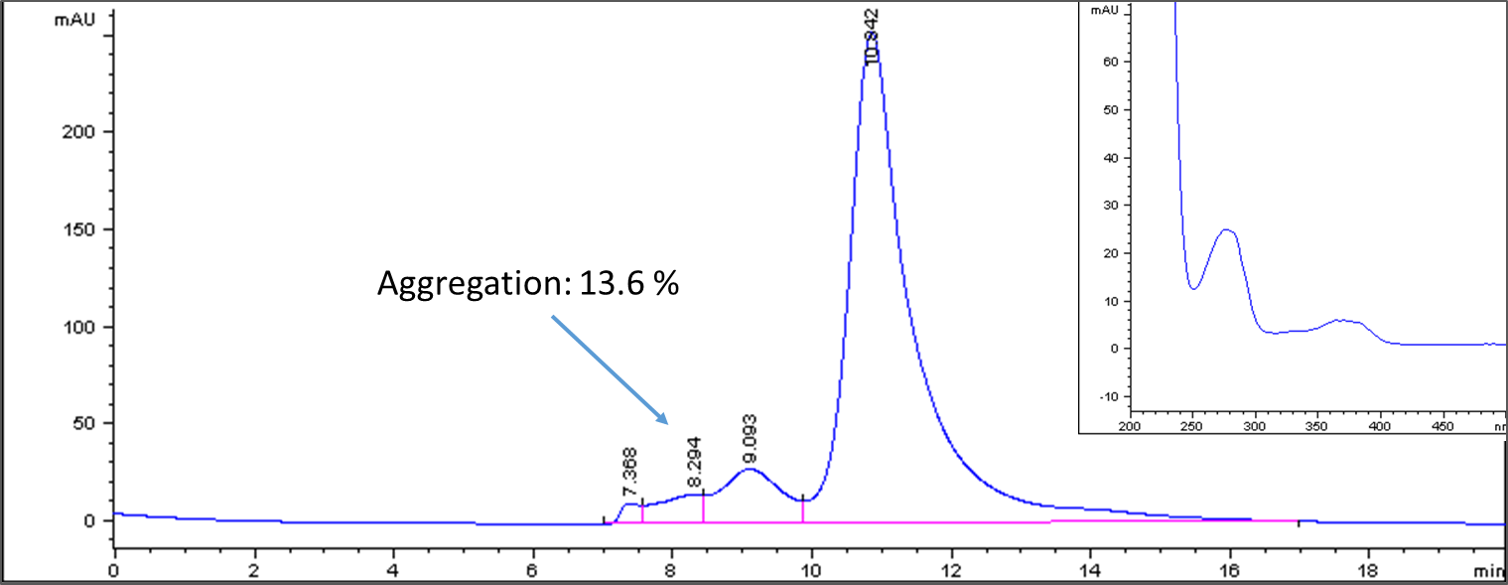
Summary of the results:
|
R value (consider the total peaks) |
0.3 |
|
Average DAR based on R value |
3.3 |
|
Extent of antibody aggregation (%) |
13.6 |
|
Unreacted antibody (%) |
0 |
|
Unreacted SN38 (%) |
0 |
|
Recovery (%) |
73.6 |
Other Considerations
Drug-to-Antibody Ratio (DAR) and Characterization by UV and HPLC
In this kit, the target DAR is 3. To estimate the DAR, you can obtain the UV absorbance ratio (R) of your conjugate at 380 nm and 280 nm.
R = (A380)/(A280)
The unlabeled antibody has no absorbance at 380 nm. A SN38-ADC with DAR of 2-4 will have an R value of 0.19-0.36.
You can also use the following formula to calculate the estimated DAR (for reference only):
DAR = (34.43 x R)/(3.44 - R)
Dox: E280 nm = 6100 M-1cm-1 (data from CellMosaic®) and E380 nm = 20985 M-1cm-1 (Nakatsuji M. et al. Human Lipocalin-Type Prostaglandin D Synthase-Based Drug Delivery System for Poorly Water-Soluble Anti-Cancer Drug SN-38. PLOS One 2015, 10(11): e0142206).
Antibody: E280 nm = 210,000 M-1cm-1 and no absorbance at 380 nm
Aggregation and Precipitation Issue for SN38 Labeling
SN38 is very hydrophobic. This kit is designed to minimize the aggregation and precipitation issues generally seen with SN38 labeling. Depending on the properties of your antibody, recovery will be 40-80%. If you are concerned with the aggregation, you can use size-exclusion chromatography (SEC) to check the extent of aggregation. If you do not have access to such a facility, you can send your sample to CellMosaic® for analysis.
Recommended Storage Conditions
SN38 is linked to antibody through a releasable linker. Recommended use within 24 h and do not store SN38-ADC. If you need to store the ADCs, please dilute your ADC in Stabilization PBS buffer (5x). Aliquot and store the conjugate in a < -20°C freezer or lyophilize to dryness. You might still see some solid precipitate out during the storage using our stabilization buffer. Please centrifuge or filtrate before use. Avoid repeated freeze and thaw cycles. If the ADC is in a lyophilized powder, after dissolving, the solution should be used immediately within 24 h. The stability of your conjugate may be different due to your antibody and should be checked by SEC HPLC.
ADC Stabilizing Buffer
CellMosaic’s proprietary ADC stabilizing PBS Buffer (CM02022) contains 5x PBS buffer and other stabilizers to prevent the hydrophobic drugs from interacting with each other during storage and causing the ADCs to precipitate out. Stabilization buffer also helps preserve the structure of the ADCs during lyophilization. The buffer is biocompatible and can be used directly for any in vitro and in vivo studies. For more information on the stabilization buffers, please check our website.
Submit Samples for HPLC Analysis
If you are submitting samples to CellMosaic® for SEC analysis, please follow these instructions:
1) Dilute your un-conjugated antibody to 1 mg/mL in PBS buffer, then transfer 50 μL of the diluted solution to a 500 μL microcentrifuge tube. Label the vial properly.
2) Transfer 50 μL of ADC (non-diluted solution) to a 500 μL microcentrifuge tube and label the vial properly.
3) Ship your samples with a cold pack for overnight delivery.
Frequently Asked Questions:
If you can’t find the answer you’re looking for or need information on general topics, please visit the main Frequently Asked Questions (FAQs) section.


